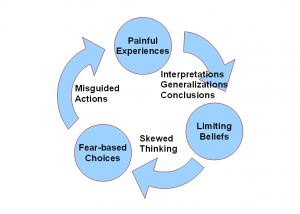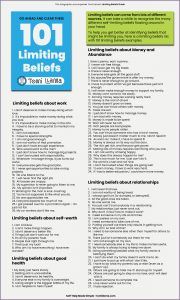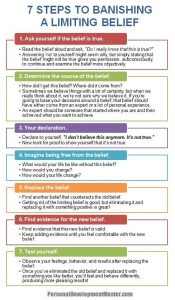By Ray Williams
October 6, 2021

Many people are feel like failures because they believe success, happiness or fulfillment has evaded them in life. These beliefs are often strongly held and don’t necessarily result from a rigorous examination of logical facts or evidence. Yet, research has shown that these self-limiting beliefs can be self-deception or false. The challenge for people who are in the grip of self-limiting beliefs is how to change them.
What are Self-Limiting Beliefs?
A belief is the attitude that something is the case or true. In epistemology, philosophers use the term “belief” to refer to personal attitudes associated with true or false ideas and concepts. However, “belief” does not require active introspection and circumspection. For example, few ponder whether the sun will rise, just assume it will.
The dictionary defines “belief” as the “acceptance by the mind that something is true or real, often underpinned by an emotional or spiritual sense of certainty.” This definition highlights the multi-dimensional nature of beliefs, which engage all aspects of who you are: mental, emotional, physical, spiritual, to name the most obvious.From one perspective, the origin of beliefs can be traced back to conclusions drawn from past experience, i.e. fire can hurt me because I have had an experience with fire that demonstrated that truth. Beliefs can be conscious and/or subconscious.
It is this multi-dimensional nature of beliefs, and the fact that they live within you on so many levels, that make them so powerful and so important to understand. Begin to understand beliefs for what they are and you will naturally begin to see where they live. Then you can begin to “get a grip” on the intricate control panel known as your belief system.
Psychologist Robert M. Williams published a research paper in the CAPA Quarterly, which describes the importance and impact of beliefs in our lives. He says, “Beliefs are like filters on a camera. What the camera ‘sees’ is a function of the filters through which it is viewing its subject. In other words, how we ‘see’ the world is a function of our beliefs and profoundly influences personality.
As a result of our beliefs, we define ourselves as worthy or worthless, powerful or powerless, competent or incompetent, trusting or suspicious, belonging or outcast, self-reliant or dependent, flexible or judgmental, fairly treated or victimized, loved or hated. Your beliefs have far reaching consequences, both positive and negative, in your life. Beliefs affect your moods, relationships, job performance, self-esteem, physical health, even your religious or spiritual outlook.”
Beliefs can be conscious and/or subconscious. Like a hard drive in a computer, this is where most of the belief-system ‘software’ is stored and, like a computer memory, the data are stored not in the central processing chip itself but, rather, in the energy field that surrounds and interpenetrates the chip. There is an analogous relationship with the brain and mind, respectively. This ‘software’ is largely responsible for our habitual thoughts and behaviors.
Advances in neuroscience have provided important information about the subconscious mind. For example, in a study cited in Harvard Professor Emeritus Gerald Zaltman’s book How Customers Think, neuroscience reveals that at least 95% of our thoughts and decisions originate at the subconscious level of the mind. That leaves a very small percentage of our decision-making capacity for the conscious mind to exercise.
These subconscious beliefs create the perceptual filters through which we respond to life’s challenges. So, while we may be mostly unaware of their influence on us, our subconscious beliefs largely ‘direct’ our observable actions and behaviors. They form the basis for our actions and reactions to each new situation in our lives.
Another important quality of the subconscious mind is its processing capacity. In his book The User Illusion, Cutting Consciousness Down to Size, author Tor Nørretranders, provides important information about the processing capacity of the conscious and subconscious minds. As remarkable as it may seem, the conscious mind processes information at an approximate rate of 40 bits of information per second. While the subconscious mind processes approximately 40 million bits of information per second. Ironically, most standard approaches to psychotherapy address only the 40-bit processor (i.e. the conscious mind). While the enormous power of the 40 million-bit processor, (i.e. the subconscious mind), is largely unused.

Neuroscience research has shown that the brain’s amygdala is connected to multiple brain regions. One of those regions is the frontal lobe, where many important decisions are processed. If the amygdala is activated, the activation affects various regions in the frontal lobe, particularly the prefrontal cortex (PFC) , and thereafter affects decision-making, as well as emotional centers. We can recognize that we are vulnerable to fear and anxiety in such a way that it compromises our own abilities to attend to relevant content.
The impact of this is that it consumes our thinking resources. We should also understand that the amygdala is the emotional relevance detector rather than just a fear detector. The amygdala-PFC connection is important because a part of it acts as short-term memory and another part as the ‘accountant’ in the brain, calculating risks and benefits of our thinking. Subconscious threats over-activate the amygdala and lead to a decline in thinking and productivity when we focus on negative statements such as:
- How am I ever going to keep up with everything?
- What if I fail?
- What if I can’t afford food, gas, healthcare on what I make?
- The government is not doing much to help me or my family, so the odds for success are stacked against me.
- What if I get laid off?
- I’m not smart enough to be successful.
These kinds of negative thought patterns can create what could be identified as an amygdala hijacking . The amygdala kicks into action in preparation for ‘fight or flight’, creatingunacceptable levels of anxiety and fear at a subconscious level that negatively impact our behavior and productivity. This subconscious patterning becomes part of the default network and will keep us focused on looking out for danger.
How Our Beliefs Impact Our Lives
Beliefs are literally the lens through which you view the world. They can:
- influence your perceptions
- define for you what is good, bad, true, real and possible
- skew your perspective in positive or negative ways
- direct and/or limit the actions you take
- shape your character
- affect your relationships
- establish a specific course you will follow
- determine your health
- harness or hijack your passion
- lower or raise your level of happiness.
Many of our beliefs are positive and useful. And different people can have different beliefs about the same experience, event or idea, which they may view as the “truth.” But we can also have false beliefs. For example, much of the western world at one time believed the sun revolved around the earth, or that the earth was flat.
Each of us lives within and operates out of a complex set of beliefs that define us and the world in which we live. Beliefs are our reality-making blueprint—the way in which we process the flood of information that comes in through our five major sense organs every single moment of every single day. Your beliefs organize the world for you. Without them to help you interpret the massive dose of stimuli that comes at you on a daily basis, you would be overwhelmed the minute you open your eyes in the morning.
What About False Beliefs?
What are false beliefs? They are beliefs we have about ourselves, others or things that are untrue and limiting. They live in our subconscious mind and since 90 percent of our actions stem from our subconscious, our false beliefs play a huge role in nearly everything we do. Also since they live in our subconscious, we may not be aware of them and how they affect our daily lives.
For example, if you believe you are unlovable, you may sabotage relationships, hold on when you shouldn’t, or avoid getting into relationships. But logic may provide you with explanations about why you are doing this when at the core it’s fueled by your false belief that you are unlovable. Our behavior stems from our beliefs. And what our life looks like is a result of our collective behavior. So if we change or dissolve our beliefs, especially our false beliefs, we can change our behavior and ultimately change our life.
Self-limiting beliefs are negative or self-critical beliefs you may have about yourself, that not only weaken your sense of self-worth, but hold you back from taking advantage of positive experiences, opportunities, or relationships.
Where Do These Self-Limiting/False Beliefs Come From?
The most important programmingof the subconscious mind occurs in the first six years of our life! Dr. Bruce Lipton, Ph.D. cellular biologist and author if the book Biology of Belief explains this process from the scientific perspective: “During that time (birth to age of six), the child’s brain is… downloading massive amounts of information about the world and how it works. By observing the behavioral patterns of people in their immediate environment—primarily parents, siblings, and relatives, children learn to distinguish acceptable and unacceptable social behaviors.
It’s important to realize that perceptions acquired before the age of six become the fundamental subconscious programs that shape the character of an individual’s life. Electroencephalogram (EEG) readings from adult brains reveal that neural electrical activity is correlated with different states of awareness. Adult EEG readings show that the human brain operates on at least five different frequency levels, each associated with a different brain state.
The predominant brain activity during the child’s first two years of life is delta, the lowest EEG frequency range. Between two and six years of age, the child’s brain activity ramps up and operates primarily in the range of theta. While in the theta state, children spend much of their time mixing the imaginary world with the real world. The predominant delta and theta activity expressed by children younger than six signifies that their brains are operating at levels below consciousness.
Delta and Theta brain frequencies define a brain state known as a hypnagogic trance, the same neural state that hypnotherapists use to directly download new behaviors into the subconscious minds of their clients.In other words, the first six years of a child’s life arespent in a hypnotic trance! When as young children we “download” limiting or sabotaging beliefs, those perceptions or misperceptions become our truths.”
Usually a single event or thought or emotion is reinforced by an event in early childhood or teenage years. You were told by someone in authority—your parents, other siblings, teachers or teenage peers—that you were not good or capable enough to do or be something or someone. The thought, emotion or memory of your behavior in that first event is continually re-visited by your mind, and whenever you are contemplating the past, or facing a new but similar event, the self-limiting belief is reinforced.
What are Some Examples of Limiting Beliefs?
It is useful for you to be deliberate about determining your self limiting beliefs. You can easily spot them by the verb “am” “is” or “are.” For example, “I am uncoordinated,” “I’m not pretty,” “men are only out for one thing,” “families are dysfunctional,” “success is a matter of luck.”
Here are some common beliefs:
- I’m not good enough to…
- I’m not pretty/handsome compared to…
- I’m not smart or as smart as…
- I don’t deserve….
- I’m too young/old/uneducated to…
- I have bad luck in ….
- I’ll never be wealthy as….
- “When I’m under pressure I usually….”
- “I often feel guilty about…”
- “I feel unworthy of…
- “When ______ happens, I get stressed and always feel….”
- “I’m always trying to avoid/stop/______”
- “I always feel responsible when________”
- “If I don’t get the approval of _____, I feel______”
- “I would be happy if________”
- “I would feel successful if _______”
- “ I need to_______ to be_______”
- “If only ______happens, then I would be______”

Is There A Cause And Effect Relationship?
It’s important to understand that your limiting beliefs are the cause of your unwanted circumstances more than you realize, not the other way around. For example, if you are struggling with your finances, you may believe you are bad with money, but the true causality runs in reverse—your limiting beliefs about money creates and perpetuates unwanted financial circumstances. So instead of believing you are a victim of your circumstances, you can change your unwanted circumstances by changing your limiting beliefs.
What Are Some Ways in Which You Can Change Your Limiting Beliefs?
- Positive Affirmations: A positive statement targeted at reprogramming an existing negative belief. Remember, any thought repeated enough can create an unconscious belief as long as the positive thought is consistent with your inner values and morality. Examples of positive affirmations:
- “My body is attractive the way it is, it doesn’t have to look like a model’s”
- “I set and uphold healthy boundaries in my relationships”
- “I invest in myself first before anyone else.”
- “I practice self-compassion as powerfully as compassion for others.”
- “A female leader can be both strong and nurturing, and not have to be like a typical male leader.”
The following are NOT examples of a positive affirmation:
- “I can be the richest man in the world.”
- “All men will fall in love with me at first meeting.”
2. Act as If. This is an action oriented strategy that is in fact borrowed both from actor training and neuroscience research. It means you act as if you do not have the negative belief but in fact have the positive equivalent or opposite. Sometimes this is referred to “fake it until you make it.” For example, if you lack some self-confidence in social situations act as if you are very confident (watch first what confident people do in those situations). Start with short duration events or appearances and repeat and expand over and over again.
3. Creative visualization (which has an element of self-hypnosis). In a relaxed state of mind and body, imagine your intended outcome in detail, in your mind as though it already exists in the present time. It’s critical here to not imagine it in the future.
4. NLP (Neuro-linguistic Programming Strategies. An example would be the “swish pattern.” Here’s the process:
- Create a picture in your mind of the habit or belief you want to change
- Let that picture dissolve.
- Create a picture in your mind of the way you would like to be,
- Change the visual intensity of this picture—size, brightness, more color, aliveness, etc.
- Bring back the first old picture in your mind and step into the picture as though you were there.
- Now insert in the lower left hand corner the small darker second picture of the desired state.
- Simultaneously, have the picture of the current negative state you are standing in rapidly shrink and recede to a distant point until it explodes. This must be done fast.
- Step back and view the new positive picture as though you were doing it from a distance.
- Repeat these steps at least 6 times.
5. An alternative written process. Follow these steps:
- Write down your limiting belief: Eg: I have trouble making conversation.
- Write down your self talk about that belief. Eg: “What if I go up to someone and they find me boring and leave. That would so embarrassing.”
- Describe your comfort zone—what would be easy for you in that situation: Eg: Just sit there by myself and watch people.
- State the opposite of your limiting belief.
- What does it feel like to have this positive belief?
- Visualize yourself taking action to make this belief happen.
- Act as if you have this belief at the first opportunity to do so.
- Repeat at least 66 times.
6. Challenging the Belief.The following process comes courtesy of Louise Hay:
Use the following questions and optional sub-questions with the concept that you are investigating. When answering the questions, close your eyes, be still, and witness what appears to you. Inquiry stops working the moment you stop answering the questions
- Is it true? (Yes or no. If no, move to question 3.)( Yes or no.)
- Can you absolutely know that it’s true?
- How do you react, what happens, when you believe that thought?
- Does that thought bring peace or stress into your life?
- What physical sensations and emotions arise when you believe the thought? Allow yourself to experience them now. (Refer to the Emotions List available on thework.com.)
- What images do you see, of past and future, when you believe the thought?
- What obsessions or addictions begin to manifest themselves when you believe the thought?(Do you act out on any of the following: alcohol, drugs, credit cards, food, sex, television?)
- How do you treat that person, others, and yourself in this situation when you believe the thought?
- Who would you be without the thought?
- Who or what are you without the thought?
- Next Step: Turn the thought around. A statement can be turned around to the self, to the other, and to the opposite. Find at least three specific, genuine examples of how each turnaround is true for you in this situation. ( For each turnaround, go back and start with the original statement. Do not turn around a statement that has already been turned around. For example, “He shouldn’t waste his time” may be turned around to “I shouldn’t waste my time,” “I shouldn’t waste his time,” and “He should waste his time.” Note that “I should waste my time” and “I should waste his time” are not valid turnarounds; they are turnarounds of turnarounds rather than turnarounds of the original statement.)
7. Using Cognitive Psychotherapy to deal with limiting beliefs.
Cognitive Behavior Therapy (CBT) is a time-sensitive, structured, present-oriented psychotherapy directed toward solving current problems and teaching clients skills to modify dysfunctional thinking and behavior. CBT is a psychotherapy that is based on the cognitive model: the way that individuals perceive a situation is more closely connected to their reaction than the situation itself. One important part of CBT is helping clients change their unhelpful thinking and behavior that lead to enduring improvement in their mood and functioning. Here are some questions used in CBT for limiting beliefs:
- Is the belief untrue or inconsistent with reality? This question helps us shake the foundations of the “old” consistency by challenging it. The idea is to find some evidence that counters your belief either completely or partially.
- Is the belief rigid? The idea with this question is to challenge whether the rules of the belief apply all the time or just some of the time or in certain contexts. To use a different example, “I must feel loved before I can lose weight” is a very rigid and confining belief. If you were to substitute the word “must” with “want” and the word “before” with “as” and remove the word “can” things start to change. “I want to feel loved as I lose weight” or what about “I can have a healthy weight independent of feeling loved”. These subtle changes in wording help to change how we process the belief and what kind of evidence we now look for.
- Is the belief extreme?If the belief is phrased as all or nothing terminology “no matter what I do” is a pretty extreme statement and the mathematical probability that is true is very low or nonexistent.
- Is the belief illogical?Is there a logical and rational connection between what you believe and what is actually occurring, or are you emotionally reacting?
- Is the belief unhelpful? Consider how does this belief help you? How does it hinder you?
8. Use a cognitive reframe. Cognitive reframing is an art as well as a science. A reframe, done artfully, can certainly help people thinkdifferently, more widely and creatively. But a cognitive reframe should be able to appeal to emotion as well as logic. Cognitive reframingis a psychological technique that consists of identifying and then disputing irrational or maladaptive thoughts. Reframing is a way of viewing and experiencing events, ideas, concepts and emotions to find more positive alternatives. In the context of cognitive therapy, cognitive reframing is referred to as cognitive restructuring. Cognitive reframing, on the other hand, refers to the process as it occurs either voluntarily or automatically in all settings.
9. Practice noticing your cognitive distortions and challenge them.
A cognitive distortion is an exaggerated or irrational thought pattern involved in the onset and perpetuation of psychopathological states, especially those more influenced by psychosocial factors, such as depressionand anxiety.Cognitive distortions are thoughts that cause individuals to perceive reality inaccurately. According to the cognitive model of psychologist Aaron Beck, a negative outlook on reality, sometimes called negative schemas (or schemata), is a factor in symptoms of emotional dysfunction and poorer subjective well-being. Specifically, negative thinking patterns cause negative emotions. During difficult circumstances, these distorted thoughts can contribute to an overall negative outlook on the world and a depressive or anxious mental state. Challenging and changing cognitive distortions is a key element of cognitive behavioral therapy (CBT).

There are many cognitive distortions, but here are a few of the most common ones that can impact limiting beliefs:
- Filtering, Magnification, Overgeneralization, Catastrophizing, Fortune Telling and Negative Predictions.: You take the negative details of a situation and magnify them in your mind, while filtering out all positive or neutral aspects of the situation. You come to a general conclusion based on a few incidents or pieces of evidence. For example, if something bad happens once or twice, you expect it to happen over and over again. You expect disaster or the worst possible outcome. You notice or hear about a problem and start with the “what ifs:” What if tragedy strikes? What if the worst happens? Your overestimate the likelihood of an occurrence. Anxiety and fear often accompany this kind of thinking, because your mind is in the future and not the present.
- Polarized Thinking: You see things as black or white, good or bad. You (or someone else) have to be perfect or you/they are a failure. There is only choice A or B. There is no middle ground or gray area. An even more extreme version is thinking you have no choice, there is only one course of action.
- Perfectionism is one type of polarized thinking—your choice or action must be perfect. Religious or political extremism is also a type of polarized thinking.
- Personalization: This is thinking that everything people do or say is some kind of reaction to you. You also compare yourself to others, trying to determine who’s smarter, better looking, more successful, etc. You think people are secretly criticizing or judging you, constantly watching you. In extreme forms this can become paranoid and narcissistic.
- Control Fallacies: You believe you can and need to control the external world—either events or people. This desire to control usually comes from a need to reaffirm your worth or self esteem, or sense of security. Often, the need for control is accompanied by anger or anxiety. The reality is the only things you can control are within you—your emotions, feelings, thinking and your behavior.
- Fallacy of Fairness, Reward and Entitlement: You feel resentful because you think you know what’s fair but other people won’t agree with you. You expect all your sacrifice and self-denial to pay off, as if there were someone keeping score. You feel bitter when the reward doesn’t come. You believe the same rules that apply to others should not apply to you. This is also acting like a victim, because your mental or emotional state is dependent on external events.
- Blaming: You hold other people responsible for your pain or inconvenience, or you take the other tack and blame yourself for every problem or reversal. People who blame others for their negative emotional or mental states (disappointment, frustration, anger etc), are acting like victims and not taking responsibility for their lives.
- “Shoulds”: You have a list of ironclad rules about how you and other people should People who break the rules anger you and you feel guilty if you violate the rules. You are critical either of others or yourself for not acting in a certain way. Judgment, criticism and guilt are often present.
- Fallacy of Change: You believe you can change other people—their beliefs, behavior or emotions, if you exert enough influence, persuasion, reward or punishment. This is self-deception.You expect that other people will change to suit you, if you just hang around long enough or if you pressure or cajole them enough. You need to change people because you feel responsible for them or because your hopes for happiness seem to depend mostly on them. Or you want them to be more like you.
- Confirmation Bias.You have a certain belief or perspective, and you are open to or seek out only those facts and information and people who reinforce your belief or perspective, and are close-minded to others’ perspectives or beliefs.
- A belief that self-criticism and self-judgment are effective ways to improve yourself.Self-criticism and self-judgment actually weaken your ability to improve performance and your self esteem. Practicing self-compassion after taking responsibility for your behavior actually makes for effective improvement.
10. Using Mindfulness to Change Limiting Beliefs
Mindfulness meditation has many benefits. Among those are increasing your capacity to live in the present, be in a state of calm, and reflect on your thoughts, emotions and physical state.
11. Journaling
- Write down the situations in your life where you are not happy with your reality
- Write down limiting beliefs you have that either caused you to make the decision to get there, or are keeping you stuck in the situation
- Write down the type of reality you want to create
- What kind of beliefs does the version of you who lives this reality have?
- How would this version of you live out these beliefs (how would this version of you act, speak, interact with others, walk in to a room? What kind of decisions would they make)?
- What can you choose to believe today to align with the reality you want to create?
Summary:
Self-limiting beliefs can be debilitating, and contribute to other problems such as anxiety and depression. Dissatisfaction and unhappiness in life can often be traced back to these limiting beliefs, so engaging in a process and activities which identify, challenge and change those beliefs can have an empowering impact on our lives.
Be sure to read my book :I Know Myself And Neither Do You: Why Charisma, Confidence and Pedigree Won’t Take You Where You Want To Go, available in paperback and ebook formats on Amazon and Barnes and Noble world-wide.


